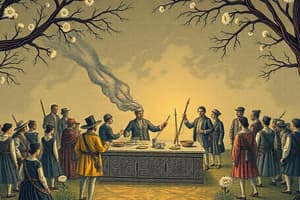Podcast
Questions and Answers
Who were some of the key figures in the abolitionist movement mentioned in the text?
Who were some of the key figures in the abolitionist movement mentioned in the text?
- Susan B. Anthony, Elizabeth Cady Stanton, and Sojourner Truth
- Harriet Tubman, Frederick Douglass, and John Brown (correct)
- George Washington, Abraham Lincoln, and Thomas Jefferson
- Martin Luther King Jr., Malcolm X, and Rosa Parks
What was the state of the abolitionist movement during the time period mentioned in the text?
What was the state of the abolitionist movement during the time period mentioned in the text?
- It had achieved its goals and was starting to disband
- It was thriving and gaining widespread support
- It was only just beginning to gain momentum
- It was in disarray and facing increasing violence (correct)
What was the main cause of the deepening divide between the North and South mentioned in the text?
What was the main cause of the deepening divide between the North and South mentioned in the text?
- Religious differences
- Slavery (correct)
- Political differences
- Economic differences
Who were some of the abolitionist allies mentioned in the text who contributed to the movement's success?
Who were some of the abolitionist allies mentioned in the text who contributed to the movement's success?
What was the crisis that was about to careen out of control mentioned in the text?
What was the crisis that was about to careen out of control mentioned in the text?
What was the main outcome of the abolitionist movement mentioned in the text?
What was the main outcome of the abolitionist movement mentioned in the text?
Flashcards are hidden until you start studying
Study Notes
Key Figures in the Abolitionist Movement
- William Lloyd Garrison, a prominent abolitionist leader who founded The Liberator, a newspaper that advocated for immediate emancipation
- Frederick Douglass, a former slave turned abolitionist orator and writer who published his autobiography, Narrative of the Life of Frederick Douglass
- Harriet Beecher Stowe, the author of Uncle Tom's Cabin, a novel that humanized slavery and highlighted its injustices
State of the Abolitionist Movement
- The movement was gaining momentum and publicity in the 1830s and 1840s, with increasing numbers of abolitionist societies and advocates
Causes of the Deepening Divide between the North and South
- The disagreement over slavery, with the North opposing its expansion and the South demanding its protection and expansion
Abolitionist Allies
- Free black communities in the North, who provided financial and moral support to the movement
- Evangelical Christians, who saw slavery as a moral evil and advocated for its abolition
Crisis about to Careen out of Control
- The conflict over slavery, which was escalating tensions between the North and South and threatening to destroy the Union
Main Outcome of the Abolitionist Movement
- The eventual abolition of slavery in the United States, achieved through the Emancipation Proclamation in 1863 and the 13th Amendment to the Constitution in 1865
Studying That Suits You
Use AI to generate personalized quizzes and flashcards to suit your learning preferences.




